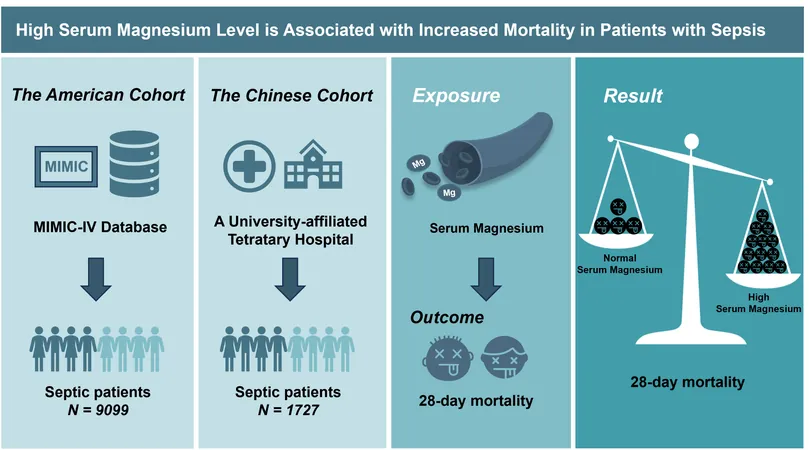
Alarming Link Found Between High Magnesium Levels and Mortality in Sepsis Patients
2024-09-19
Author: Wei
Introduction
Sepsis is a life-threatening condition that affects millions worldwide—reportedly around 48.9 million cases in 2017 alone, making it responsible for nearly 19.7% of total global deaths. The World Health Organization (WHO) has identified sepsis as a critical global health priority due to its severe implications for patient outcomes.
Importance of Timely Intervention
Timely identification and intervention are pivotal in managing sepsis and septic shock, making risk stratification crucial for improving life-saving treatments. A recent groundbreaking international multicenter study led by Dr. Bo Hu from Wuhan University, China, has unveiled a concerning correlation between elevated serum magnesium levels and heightened 28-day mortality rates in patients suffering from sepsis. This comprehensive analysis included data from 10,826 sepsis patients across the United States and China, emphasizing the need for focused monitoring of serum magnesium levels to assess patient risk effectively. The findings are detailed in the journal *Medcomm*.
Study Details
By leveraging the extensive MIMIC-IV database alongside a cohort from a prominent tertiary hospital in China, researchers examined serum magnesium levels, severity scores, and corresponding 28-day mortality rates at the onset of sepsis. Astonishingly, they found that patients presenting with elevated serum magnesium levels not only had more severe clinical conditions but also carried a substantially increased risk of early mortality. Notably, this correlation held true even after accounting for various confounding factors, indicating a robust relationship between magnesium levels and patient outcomes.
Key Findings and Implications
Importantly, the study validated this link across diverse ethnic backgrounds and healthcare environments, highlighting the urgent need for healthcare professionals to monitor serum magnesium levels closely in clinical practices. Elevated magnesium levels might contribute to adverse outcomes in septic patients through several mechanisms, including exacerbation of hemodynamic instability, impairment of neuromuscular transmission, impacts on respiratory function, and intensification of inflammatory responses—all of which can aggravate the already critical state associated with sepsis.
Future Directions
As healthcare systems strive to enhance patient care, this study underscores an essential avenue for further investigation into how serum magnesium levels could be used as predictive indicators for identifying high-risk sepsis patients. Such insights could revolutionize approaches to treatment, enabling clinicians to tailor therapies that could improve survival rates and overall patient management strategies.
Conclusion
With the ongoing challenges posed by sepsis in clinical settings, understanding the implications of serum magnesium levels may reveal new resources for improving prognosis and care for these vulnerable patients. The medical community is urged to further explore the specific mechanisms at play, which could open new frontiers in the fight against sepsis-related mortality. Stay tuned for more updates on this crucial topic and the potential it carries for changing patient outcomes dramatically!


 Brasil (PT)
Brasil (PT)
 Canada (EN)
Canada (EN)
 Chile (ES)
Chile (ES)
 Česko (CS)
Česko (CS)
 대한민국 (KO)
대한민국 (KO)
 España (ES)
España (ES)
 France (FR)
France (FR)
 Hong Kong (EN)
Hong Kong (EN)
 Italia (IT)
Italia (IT)
 日本 (JA)
日本 (JA)
 Magyarország (HU)
Magyarország (HU)
 Norge (NO)
Norge (NO)
 Polska (PL)
Polska (PL)
 Schweiz (DE)
Schweiz (DE)
 Singapore (EN)
Singapore (EN)
 Sverige (SV)
Sverige (SV)
 Suomi (FI)
Suomi (FI)
 Türkiye (TR)
Türkiye (TR)
 الإمارات العربية المتحدة (AR)
الإمارات العربية المتحدة (AR)